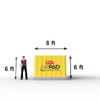Enhancing Workplace Safety with Fall Protection Airbags
In today's dynamic work environments, ensuring the safety of workers operating at elevated heights is paramount. Every year, falls from heights remain one of the leading causes of workplace fatalities and injuries, highlighting the critical need for effective fall protection measures. This is where fall protection airbags emerge as a game-changer, offering a reliable solution to mitigate the risks associated with falls from heights.
Understanding Fall Protection Airbags
Fall protection airbags, also known as fall arrest airbags, are advanced safety systems designed to cushion the impact of falls from elevated surfaces. Leveraging principles of physics and engineering, these airbags rapidly inflate upon detecting a fall, creating a soft landing surface that absorbs the force of impact. Versatile and adaptable, fall protection airbags find applications across a spectrum of industries, from construction and film production to sports and entertainment.
The Benefits of Fall Protection Airbags
- Enhanced Safety: Fall protection airbags drastically reduce the risk of severe injuries or fatalities associated with falls from heights, providing workers with a reliable safety net.
- Versatility: These systems are adaptable to various work environments, including construction sites, industrial facilities, and entertainment venues, offering comprehensive protection in diverse settings.
- Quick Deployment: With swift inflation times, fall protection airbags offer near-instantaneous protection, minimizing the time workers spend in free fall and reducing the potential for injury.
- Reusable and Cost-Effective: Many fall protection airbag systems are reusable, making them a cost-effective long-term investment for businesses. By minimizing the need for frequent replacements, these systems offer significant savings over time.
- Compliance: Employing fall protection airbags aligns with safety regulations and standards, ensuring legal compliance for businesses and providing peace of mind for employers and workers alike.
Applications Across Industries
The versatility of fall protection airbags makes them invaluable across various industries:
- Construction: Workers on scaffolding, rooftops, or high-rise structures benefit from the added safety net provided by airbag systems, reducing the risk of falls and injuries.
- Film and Entertainment: Stunt performers and rigging crews utilize fall protection airbags to minimize risks during aerial maneuvers and stunts, ensuring the safety of cast and crew members on set.
- Sports: In sporting events like skiing, snowboarding, or gymnastics, airbags offer athletes a safer environment to practice and perform complex maneuvers, reducing the risk of injuries during training and competitions.
Addressing Common Adoption Challenges
While fall protection airbags offer significant safety benefits, their adoption may pose challenges for businesses:
- Cost Considerations: The initial investment cost of fall protection airbag systems can be a deterrent for some businesses, especially smaller enterprises with limited budgets. However, businesses should consider the long-term savings and benefits offered by these systems in terms of reduced injury claims, insurance premiums, and legal liabilities.
- Compatibility and Integration: Ensuring compatibility with existing safety equipment and seamless integration into the workflow are crucial considerations for businesses adopting fall protection airbag systems. Conducting thorough compatibility assessments and providing comprehensive training can help address these concerns.
- Training and Familiarization: Effective utilization of fall protection airbags requires proper training and familiarization with the equipment. Businesses must allocate resources for training programs to ensure that workers are comfortable and confident in operating the equipment safely.
- Maintenance and Inspection: Regular maintenance and inspection are essential to ensure the optimal performance and compliance of fall protection airbag systems. Businesses should establish maintenance schedules and protocols to ensure the ongoing safety and reliability of these systems.
- Regulatory Compliance: Meeting regulatory requirements and standards is crucial for businesses adopting fall protection airbags. Employers should ensure that the airbag systems they invest in comply with industry-specific regulations and standards for safety equipment to avoid fines, legal repercussions, and reputational damage.
Looking Towards the Future
As technology continues to evolve, so too will fall protection airbag systems. Innovations in sensor technology, materials science, and deployment mechanisms will likely enhance the effectiveness and efficiency of these safety solutions. Furthermore, increased awareness of workplace safety and regulatory standards will drive broader adoption across industries, ensuring that workers remain protected in high-risk environments.
In conclusion, fall protection airbags represent a significant advancement in workplace safety, offering an effective means of mitigating the risks associated with falls from heights. By addressing common adoption challenges and providing comprehensive support, businesses can harness the full potential of fall protection airbags to create safer work environments for their employees. As industries continue to prioritize safety and embrace innovative solutions, fall protection airbags will play an integral role in reshaping safety standards and fostering a culture of workplace safety.


















